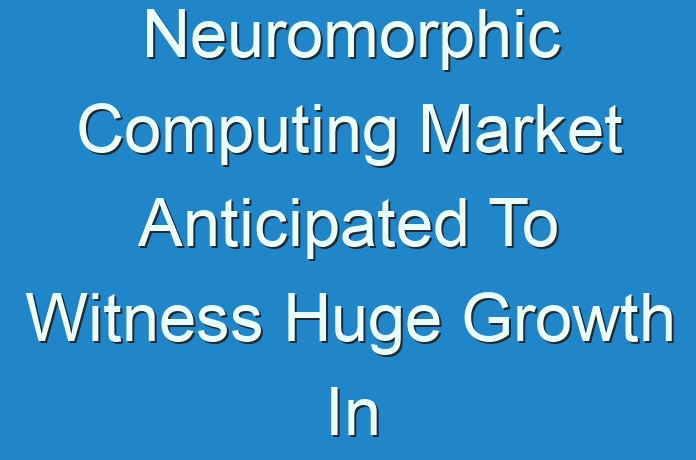
Neuromorphic computing or neuromorphic engineering has been described as the use of large integration systems containing numerous analog circuits allowing the replication of neuro-biological behaviors existing in a human’s nervous system. The neuromorphic computing platform consists of two vital systems based on the custom hardware architecture. Such systems are designed to program neural microcircuits by applying brain-like thought process in cognitive computing and machine learning process. This procedure enables a machine to learn, adapt and function like a human brain does rather than functioning like a normal computer. In addition, to perform such a complex task, the computing platform requires the state-of-the-art circuit technologies and electronic components, which allows the platform to receive new data or knowledge gained from various other sources of neuroscience research, e.g. theoretical neuroscience, brain modelling and experimental neuroscience.
Get Sample Copy:
https://www.transparencymarketresearch.com/sample/sample.php?flag=S&rep_id=15554
The neuromorphic computing systems are programmed as brain inspiring devices, which are capable for low energy and high speed simulations of synaptic plasticity with spiking neural networks. The two neuromorphic computing systems are BrainScaleS system and SpiNNaker system. The BrainScaleS system is purely based on mixed signal and analogue emulations of neuron, synapse of plasticity models with digital connectivity going up to 10,000 times faster than the real time. The SpiNNaker system on the other hand is based on numerical model, which runs in real time on custom digital multicore chips. The simulation and models for this system is provided in Python script, which uses PyNN API.
Neuromorphic computing is expected to gain huge momentum in the coming years due to the gaining familiarity of neuromorphic computing technology and rising demand for artificial intelligence. Artificial intelligence is used as applications in language processing, computer vision and image processing, translation and chatterbots, and non-linear controls and robotics. In addition, increasing application and usage of software in neuromorphic computing is also set to drive the growth of this market. Softwares in neuromorphic computing is used as various applications such as predictive analysis, machine vision, video monitoring, online learning and data modelling among others. There has been an emerging trend of combining embodied models and neuroscience computation for the application of neuromorphic chips in cognitive and brain-based robots.
Grab an exclusive PDF Brochure of this report:
https://www.transparencymarketresearch.com/sample/sample.php?flag=B&rep_id=15554
Major companies in the neuromorphic computing market are improving their efforts in their research and development activities and marketing strategies for the commercialization of neuromorphic chips. Such initiatives is expected to help companies penetrate into new areas of market and create awareness for the new technology and products involved supporting the advancement of neuromorphic computing technology. Moreover, the replacement of Von Neumann chips by neuromorphic chips is also expected to bolster the growth of neuromorphic computing industry, exponentially. Neuromorphic chips exhibit qualities such as low power consumption, high speed accuracy and optimum memory usage. However, limited research and development in this market due to huge investment and advanced technologies required, coupled with complexity in the designing and manufacturing of neuromorphic chips are the major factors inhibiting the growth of neuromorphic computing market.
The neuromorphic computing market can be categorized into five application segments such as image processing, signal processing, object detection, data processing and others. The signal processing market is expected to show significant growth in the coming years owing to the rising demand for acoustics signal and processing of audio. By end-use, the market can be segregated into five segments such as automotive, consumer electronics, automotive, defense, healthcare and others. The consumer electronics is expected to hold the largest share in terms of end-use application of neuromorphic computing. The usage of neuromorphic computing in self-driven and smart vehicles is expected to bring a transition in transportation and furthermore, propel the growth of automotive sector. The usage of neuromorphic chips in satellites for surveillance and aerial imagery is highly in demand in the defense sector.
The key players in the neuromorphic computing market include Hewlett-Packard (U.S.), IBM Corporation (U.S.), Samsung Electronics Co. Ltd. (South Korea), Qualcomm Inc. (U.S.), Intel Corporation (U.S.), Brain Corporation (U.S.), HRL Laboratories (U.S.), General Vision Inc (U.S.), Vicarious (U.S.), Knowm Inc. (U.S.), Numenta (U.S.), and CEA-Leti (France) among others.
Request For PreBook Report@:
https://www.transparencymarketresearch.com/checkout.php?rep_id=15554<ype=S
This study by TMR is all-encompassing framework of the dynamics of the market. It mainly comprises critical assessment of consumers’ or customers’ journeys, current and emerging avenues, and strategic framework to enable CXOs take effective decisions.
Our key underpinning is the 4-Quadrant Framework EIRS that offers detailed visualization of four elements:
- Customer Experience Maps
- Insights and Tools based on data-driven research
- Actionable Results to meet all the business priorities
- Strategic Frameworks to boost the growth journey
The study strives to evaluate the current and future growth prospects, untapped avenues, factors shaping their revenue potential, and demand and consumption patterns in the global market by breaking it into region-wise assessment.
The following regional segments are covered comprehensively:
- North America
- Asia Pacific
- Europe
- Latin America
- The Middle East and Africa
Read Latest Press Release By TMR:





